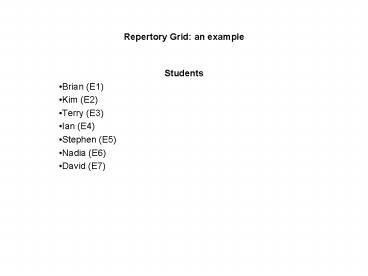Repertory Grid: an example - PowerPoint PPT Presentation
1 / 12
Title:
Repertory Grid: an example
Description:
Brian (E1), Kim(E2) and Terry(E3) E1 and E3 are similar (school-leaver), E2 ... for scruffy (C9) 3-1 = 2 = 2. total = 17. Distance Matrix. E1 E2 E3 E4 E5 E6 E7 ... – PowerPoint PPT presentation
Number of Views:1191
Avg rating:3.0/5.0
Title: Repertory Grid: an example
1
Repertory Grid an example
- Students
- Brian (E1)
- Kim (E2)
- Terry (E3)
- Ian (E4)
- Stephen (E5)
- Nadia (E6)
- David (E7)
2
The Session
- Three students selected at random
- Brian (E1), Kim(E2) and Terry(E3)
- E1 and E3 are similar (school-leaver), E2 is
different (mature) - Construct (C1) is school-leaver
--------------------------- mature - E4 is mature
- E5 is mature
- E6 is mature
- E7 is mature
- Rating grid becomes
- E1 E2 E3 E4 E5 E6 E7
- C1 3 1 3 1 1 1 1 C1
- (school-leaver) (mature)
3
(No Transcript)
4
Distance between concepts
- eg between E1 and E2 sum of absolute values of
the difference for each construct. - for school leaver(C1) 3-1 2 2
- for poor qualifications (C2) 1-2 -1 1
- for unsure (C3) 3-1 2 2
- for asks questions (C4) 1-3 -2 2
- for good attendance (C5) 1-3 -2 2
- for does work (C6) 1-3 -2 2
- for joins in socially (C7) 1-3 -2 2
- for not organised (C8) 3 -1 2 2
- for scruffy (C9) 3-1 2 2
- total 17
5
Distance Matrix
- E1 E2 E3 E4 E5 E6 E7
- E1 0 17 12 8 6 13 10
- E2 0 5 9 14 4 7
- E3 0 10 12 9 8
- E4 0 6 6 6
- E5 0 9 8
- E6 0 11
- E7 0
6
Calculating a hierarchy
- find the smallest distance E2 is closest to E6
4
E2
E6
7
Re-draw the distance matrix
- Use an average approach
- eg dist(E2,E1) 17, dist(E6,E1) 13 gt
dist(E2/E6,E1) average(17,13) 15 - E2/E6 E1 E3 E4 E5 E7
- E2/E6 0 15 7 7.5 11.5 9
- E1 0 12 8 6 10
- E3 0 10 12 8
- E4 0 6 6
- E5 0 8
- E7 0
8
Modifying Hierarchy
6
4
E2
E6
E5
E1
E4
E7
9
Re-draw the distance matrix
- Again use an average approach eg
- dist(E2/E6, E1/E5/E4/E7)) average of
- dist(E2/E6,E1)
- dist(E2/E6,E5)
- etc
- i.e. average(15,11.5,7.5,9) 10.75
- E2/E6 E1/E5/E4/E7 E3
- E2/E6 0
- E1/E5/E4/E7 10.75 0
- E3 7 10.5 0
10
Modifying the Hierarchy
13
7
6
4
E2
E6
E5
E1
E4
E7
E3
11
Re-draw the distance matrix
- All we need to now is to calculate the distance
between (E2/E6/E3) and (E1/E5/E4/E7) - i.e. average of dist(E2/E6, E1/E5/E4/E7) and
dist(E3,E1/E5/E4/E7) - (10.75 10.5)/2 10.625
12
Modifying the Hierarchy
11
7
6
4
E2
E6
E5
E1
E4
E7
E3































